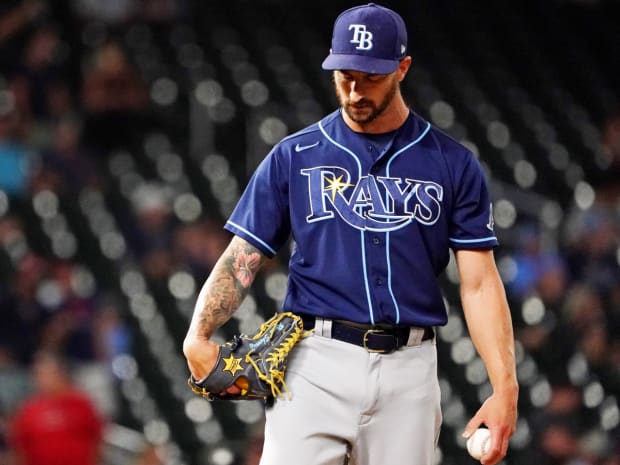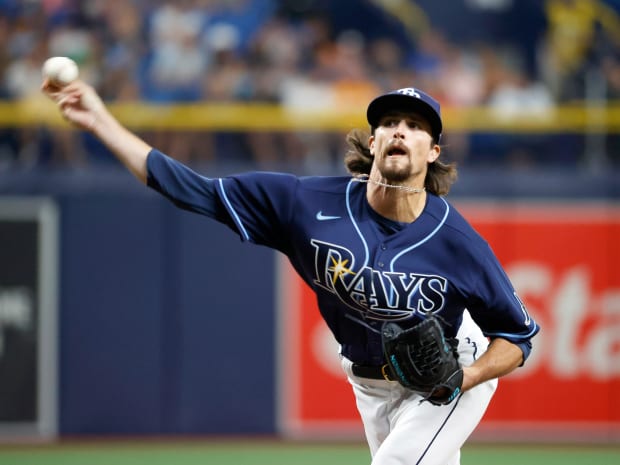They are the model postmodern franchise. But that doesn't mean their style is good for baseball.
Welcome to The Opener, where every weekday morning you’ll get a fresh, topical column to start your day from one of SI.com’s MLB writers.
On Friday the Rays signed reliever David Hess, 28. On Saturday they activated him for a game in which he did not pitch. On Sunday they designated him for assignment.
Over the same weekend, on Friday they recalled reliever Chris Mazza, 31, from the minors, on Saturday they optioned him to the minors, and on Sunday they recalled him from the minors. They have optioned or recalled Mazza 15 times this year. His average stay on the big league roster: 3.7 days.
It was just another typical weekend for the Rays, who won two of three vs. the White Sox by using 14 pitchers. In many ways they are the model postmodern franchise. Only the Dodgers have won more games than Tampa Bay over the past three seasons, and the Rays have done it with payrolls that ranked 30th, 28th and 26th.
Watch MLB games online all season long with fuboTV: Start with a 7-day free trial!
They also have done it with an offense that has struck out more times than any team but the Tigers, and with a pitching carousel that has churned through 66 different pitchers—more than half of whom (34) lasted less than 15 appearances. If this is the new model, the players association should be concerned. The Rays are wickedly smart, and, in the business of winning baseball games efficiently, no franchise does it better. But in the business of entertaining, the style does not sell. What should bother the PA is how players, especially pitchers, are being treated as fungible assets.

Nick Wosika/USA TODAY Sports
The churn rate in Tampa Bay is so high that the Rays:
• Used a franchise record 35 pitchers to play the first 110 games this year.
• Made 173 procedural moves with pitchers in the first 144 days of this season.
• Placed a pitcher on the injured list 31 times in the first 21 weeks.
• Used five or more pitchers in a game 50 times this year.
• Have only five pitchers left on the roster from 2019, including only one from the 11 used in the 2019 ALDS on their active roster today (Ryan Yarbrough).
The Rays have leveraged the growth and advances in the throwing culture better than any other franchise. Advances in technology and training mean the universe of pitchers with major league stuff has expanded greatly and quickly. Pitching labs and colleges are cranking out hard throwers. Tampa Bay is expert at figuring out which pitch characteristics play up, how deception in delivering a baseball can improve performance and how limiting the exposure of pitchers to hitters makes hitting more difficult.
Rays starters average 75 pitches per start this year, tied with the Mets for the fewest in baseball. They also were last in pitches per start last year (71), the year before that (70) and the year before that (63). Over the past two years, no team throws fewer fastballs than the Rays (44.5%, not including cutters).
Chaz Roe is a good example of how Tampa Bay finds and uses pitchers. The journeyman reliever was throwing 14% sliders when the Rays acquired him in 2017. Within two years he was throwing 64% sliders—until he broke down this year and needed shoulder surgery. Or maybe it’s Oliver Drake, or Colin Poche, or Pete Fairbanks, or Nick Anderson, or Ryan Thompson, or … well, you get the idea. Churn, sometimes caused by injuries from throwing unconventionally, can happen at such a high rate only when the supply supports it.

Kim Klement/USA TODAY Sports
Meanwhile, the fungible nature of relief pitching across baseball is placing enormous pressure on relievers. Rays reliever Ryan Sherriff, 31, told Sports Illustrated earlier this year about how his mental health suffered from the pressure to be perfect. Since returning from the restricted list, the Rays have optioned or recalled him nine times. The ground is always insecure beneath the feet of a big league reliever.
Mazza is the epitome of a fungible reliever, especially those with minor league options. He has pitched for five organizations and been released or designated for assignment four times. Here are his transactions with the Rays this year:
- April 5 Recalled
- April 17 Optioned
- April 18 Recalled
- April 22 Optioned
- April 23 Recalled
- April 24 Placed on IL (shoulder)
- May 19 Sent on rehab
- May 22 Optioned
- June 16 Recalled
- June 17 Optioned
- July 21 Recalled
- July 23 Optioned
- July 29 Recalled
- Aug. 3 Optioned
- Aug. 20 Recalled
- Aug. 21 Optioned
- Aug. 22 Recalled
He has pitched 11 times and been optioned seven times. Of the six times he pitched more than one inning, the Rays took him off the roster the next day four times. It has become common practice around baseball: When a pitcher with options needs a recovery day, he gets shipped to the minors and a fresh arm is shipped in. It is a world in which relievers get penalized for doing a good job.
In just the past decade the number of major league pitchers has grown by 25%. That may sound like a good trend for the players; 169 more big league pitching jobs in 10 years. But these are not full-time jobs. The number of games is fixed (4,830 team games in a full season). The “growth” in jobs is actually a growth in gig-economy jobs—shared jobs.
Teams now use one pitcher for every 4.5 team games played—almost double the churn rate from 30 years ago:
With five weeks left in the season, major league teams have used more pitchers than ever before. With the best record in the American League, the Rays are playing this postmodern style better than any other club.
More MLB Coverage:
• Miguel Cabrera's Swing Stands Up to Father Time
• Can the Padres Hold Their Playoff Spot?
• Return of Bruised Bombers Bolsters Red-Hot Yankees
• Toronto’s Playoff Hopes Dwindle as Losses Pile Up
Sports Illustrated may receive compensation for some links to products and services on this website.